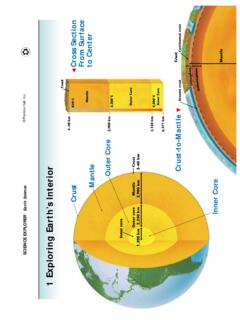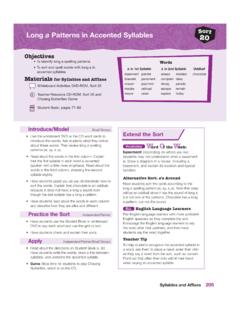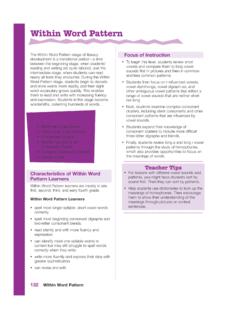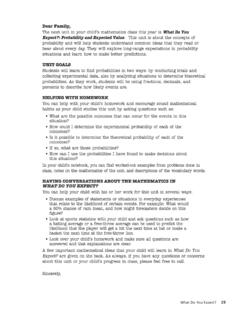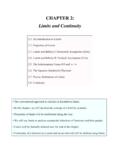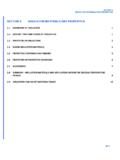Transcription of Chapter 2 Limits and Continuity - Prentice Hall
1 58 ChapterAn Economic Injury Level (EIL) is a measure-ment of the fewest number of insect peststhat will cause economic damage to a crop or forest. It has been estimated that monitoring pest populations and establishing EILs can reducepesticide use by 30% 50%.Accurate population estimates are crucial fordetermining EILs. A population density of one in-sect pest can be approximated byD(t) 9t02 3t pests per plant, where tis the number of dayssince initial infestation. What is the rate of changeof this population density when the populationdensity is equal to the EIL of 20 pests per plant? section can help answer this and 12/16/05 12:13 PM Page 58 Chapter 2 OverviewThe concept of limit is one of the ideas that distinguish calculus from algebra this Chapter , we show how to define and calculate Limits of function values. The cal-culation rules are straightforward and most of the Limits we need can be found by substitu-tion, graphical investigation, numerical approximation, algebra, or some combination of the uses of Limits is to test functions for Continuity .
2 Continuous functions arisefrequently in scientific work because they model such an enormous range of natural be-havior. They also have special mathematical properties , not otherwise of Change and LimitsAverage and Instantaneous SpeedA moving body s average speedduring an interval of time is found by dividing the dis-tance covered by the elapsed time. The unit of measure is length per unit time kilometersper hour, feet per second, or whatever is appropriate to the problem at 1 Finding an Average SpeedA rock breaks loose from the top of a tall cliff. What is its average speed during the first2 seconds of fall?SOLUTIONE xperiments show that a dense solid object dropped from rest to fall freely near the sur-face of the earth will fally 16t2feet in the first tseconds. The average speed of the rock over any given time interval isthe distance traveled, y,divided by the length of the interval the first 2 secondsof fall, from t 0 to t 2, we have yt 16 2 22 016 0 2 32 sfetc.
3 Now try Exercise 2 Finding an Instantaneous SpeedFind the speed of the rock in Example 1 at the instant t NumericallyWe can calculate the average speed of the rock over the intervalfrom time t 2 to any slightly later time t 2 has yt .(1)We cannot use this formula to calculate the speed at the exact instant t 2 because thatwould require taking h 0, and 0 0 is undefined. However, we can get a good idea ofwhat is happening at t 2 by evaluating the formula at values of hcloseto 0. When wedo, we see a clear pattern (Table on the next page). As happroaches 0, the averagespeed approaches the limiting value 64 2 h 2 16 2 2 hSection of Change and you ll learn about .. Average and InstantaneousSpeed Definition of Limit properties of Limits One-sided and Two-sided Limits Sandwich Theoremand why .. Limits can be used to describecontinuity, the derivative, and theintegral: the ideas giving thefoundation of FallNear the surface of the earth, all bodiesfall with the same constant distance a body falls after it is re-leased from rest is a constant multipleof the square of the time fallen.
4 At least,that is what happens when a body fallsin a vacuum, where there is no air toslow it down. The square-of-time rulealso holds for dense, heavy objects likerocks, ball bearings, and steel tools dur-ing the first few seconds of fall throughair, before the velocity builds up towhere air resistance begins to air resistance is absent or in-significant and the only force acting ona falling body is the force of gravity, wecall the way the body falls free 12/16/05 12:13 PM Page 59 Confirm AlgebraicallyIf we expand the numerator of Equation 1 and simplify, wefind that yt 64h h16h2 64 values of hdifferent from 0, the expressions on the right and left are equivalent andthe average speed is 64 16 can now see why the average speed has thelimiting value 64 16(0) 64 ft/sec as happroaches try Exercise of LimitAs in the preceding example, most Limits of interest in the real world can be viewed as nu-merical Limits of values of functions. And this is where a graphing utility and calculuscome in.
5 A calculator can suggest the Limits , and calculus can give the mathematics forconfirming the Limits give us a language for describing how the outputs of a function behave as the inputs approach some particular value. In Example 2, the average speed was not defined ath 0 but approached the limit 64 as happroached 0. We were able to see this numericallyand to confirm it algebraically by eliminating hfrom the denominator. But we cannot al-ways do that. For instance, we can see both graphically and numerically (Figure ) thatthe values of f(x) (sin x) xapproach 1 as xapproaches cannot eliminate the xfrom the denominator of (sin x) xto confirm the observationalgebraically. We need to use a theorem about Limits to make that confirmation, as you willsee in Exercise 4 4h h2 64 h16 2 h 2 16 2 2 h60 Chapter 2 Limits and ContinuityFigure (a) A graph and (b) table ofvalues for f x sin x xthat suggest thelimit of fas xapproaches 0 is Speeds overShort Time Intervals Starting at t 2 yt Length ofAverage SpeedTime Interval,for Intervalh(sec) y t(ft/sec) 2 h 2 16 2 2 h[ 2p, 2p] by [ 1, 2](a)XY1 = sin(X)/X.
6 3 .2 . (b)The sentence limx cf x Lis read, The limit offof xas xapproaches cequals L. The notation means that the values f(x) of the function fapproach or equal Las the valuesof xapproach (but do not equal) A3 provides practice applying the definitionof saw in Example 2 that limh 0 64 16h suggested in Figure ,limx 0 sinxx illustrates the fact that the existence of a limit as x cnever depends on howthe function may or may not be defined at function fhas limit 2 as x 1 even thoughfis not defined at 1. The function ghas limit 2 as x 1 even though g 1 2. The functionhis the only one whose limit as x 1 equals its value at x cand Lbe real numbers. The function fhas limit Las xapproaches cif, givenany positive number e,there is a positive number dsuch that for all x,0 x c d f x L .We writelimx cf x 12/16/05 12:13 PM Page 60 section of Change and Limits61 THEOREM 1 properties of LimitsIf L,M,c,andkare real numbers andlimx cf x Landlimx cg x M, Rule:limx c f x g x L MThe limit of the sum of two functions is the sum of their Rule:limx c f x g x L MThe limit of the difference of two functions is the difference of their Rule:limx c f x g x L MThe limit of a product of two functions is the product of their Multiple Rule:limx c k f x k LThe limit of a constant times a function is the constant times the limit of Rule:limx c gf xx ML ,M 0 The limit of a quotient of two functions is the quotient of their Limits , providedthe limit of the denominator is not of LimitsBy applying six basic facts about Limits , we can calculate many unfamiliar Limits fromlimits we already know.
7 For instance, from knowing thatlimx c k kLimit of the function with constant value kandlimx c x c,Limit of the identity function at x cwe can calculate the Limits of all polynomial and rational functions. The facts are listed inTheorem 10yx211 10yx211 10yx f(x) =(a),(b)x2 1x 1x2 1x 1x 11,x = 1x + 1 g(x) =(c) h(x) =Figure 1f x limx 1g x limx 1h x 12/16/05 12:13 PM Page 61 Here are some examples of how Theorem 1 can be used to find Limits of polynomialand rational 3 Using properties of LimitsUse the observations limx ck kand limx cx c,and the properties of Limits tofind the following Limits .(a) limx c x3 4x2 3 (b) limx c x4x 2x 25 1 SOLUTION(a) limx c x3 4x2 3 limx cx3 limx c4x2 limx c3 Sum and Difference Rules c3 4c2 3 Product and Multiple Rules(b) limx c x4x 2x 25 1 limx climx xc4 x 2x 25 1 Quotient Rule Sum and Difference Rules c4c 2c 25 1 Product RuleNow try Exercise 5 and 3 shows the remarkable strength of Theorem 1. From the two simple observa-tions that limx ck kand limx cx c,we can immediately work our way to Limits ofpolynomial functions and most rational functions using cx4 limx cx2 limx c1 limx cx2 limx c562 Chapter 2 Limits and Rule:If rand sare integers,s 0, thenlimx c f x r s Lr sprovided that Lr sis a real limit of a rational power of a function is that power of the limit of the func-tion, provided the latter is a real 2 Polynomial and Rational f x anxn an 1xn 1.
8 A0is any polynomial function and cis anyreal number, thenlimx cf x f c ancn an 1cn 1 .. f x and g(x) are polynomials and cis any real number, thenlimx c gf xx gf cc ,provided that g c 12/16/05 12:13 PM Page 62 EXAMPLE 4 Using Theorem 2(a) limx 3 x2 2 x 3 2 2 3 9(b) limx 2 x2 x 2x2 4 2 2 2 2 22 4 142 3 Now try Exercises 9 and with polynomials, Limits of many familiar functions can be found by substitution atpoints where they are defined. This includes trigonometric functions, exponential and log-arithmic functions, and composites of these functions. Feel free to use these 5 Using the Product RuleDetermine limx 0 tanxx .SOLUTIONS olve GraphicallyThe graph of f x tanx xin Figure suggests that the limitexists and is about AnalyticallyUsing the analytic result of Exercise 75, we havelimx 0 tanxx limx 0( sinxx co1sx )tanx= csoinsxx limx 0 sinxx limx 0 co1sx Product Rule 1 co1s0 1 11 try Exercise we can use a graph to discover that Limits do not exist, as illustrated by Example 6 Exploring a Nonexistent LimitUse a graph to show thatlimx 2 xx3 21 does not that the denominator is 0 when xis replaced by 2, so we cannot use substitutionto determine the limit.
9 The graph in Figure of f(x) (x3 1 x 2) strongly sug-gests that as x 2 from either side, the absolute values of the function values get verylarge. This, in turn, suggests that the limit does not try Exercise and Two-sided LimitsSometimes the values of a function ftend to different Limits as xapproaches a number cfrom opposite sides. When this happens, we call the limit of fas xapproaches cfrom theSection of Change and Limits63[ p, p] by [ 3, 3]Figure graph of f x tanx xsuggests that f x 1 as x 0. (Example 5)[ 10, 10] by [ 100, 100]Figure graph off(x) (x3 1 x 2) obtained using parametric graphing to pro-duce a more accurate graph. (Example 6) 12/16/05 12:13 PM Page 63right the right-hand limitof fat cand the limit as xapproaches cfrom the left the left-hand limitof fat is the notation we use:right-hand:limx c f x The limit of f as x approaches c from the :limx c f x The limit of f as x approaches c from the 7 Function Values Approach Two NumbersThe greatest integer function f(x) int xhas different right-hand and left-hand Limits ateach integer, as we can see in Figure For example,limx 3 intx 3andlimx 3 intx try Exercises 31 and limit of int xas xapproaches an integer nfrom the right is n,while the limit as xap-proaches nfrom the left is n sometimes call limx cf x the two-sided limitof fat cto distinguish it from theone-sidedright-hand and left-hand Limits of fat 3 shows how these Limits are 2 Limits and ContinuityTHEOREM 3 One-sided and Two-sided LimitsA function f(x) has a limit as xapproaches cif and only if the right-hand and left-hand Limits at cexist and are equal.
10 In symbols,limx cf x L limx c f x Landlimx c f x , the greatest integer function f(x) int xof Example 7 does not have a limit asx 3 even though each one-sided limit 8 Exploring Right- and Left-Hand LimitsAll the following statements about the function y f(x) graphed in Figure are x 0:limx 0 f x x 1:limx 1 f x 0even though f 1 1,limx 1 f x 1,fhas no limit as x 1. (The right- and left-hand Limits at 1 are not equal, solimx 1f x does not exist.)At x 2:limx 2 f x 1,limx 2 f x 1,limx 2f x 1even though f 2 x 3:limx 3 f x limx 3 f x 2 f 3 limx 3f x .At x 4:limx 4 f x noninteger values of cbetween 0 and 4,fhas a limit as x try Exercise = int xxy332121 2 144 Figure each integer, the greatestinteger function y int xhas differentright-hand and left-hand Limits . (Example 7)2101234xyy = f(x)On the Far SideIf fis not defined to the left of x c,then fdoes not have a left-hand limit , if fis not defined to theright of x c,then fdoes not have aright-hand limit at graph of the function x 1,0 x 11,1 x 2f x {2,x 2x 1,2 x 3 x 5,3 x 4.}
